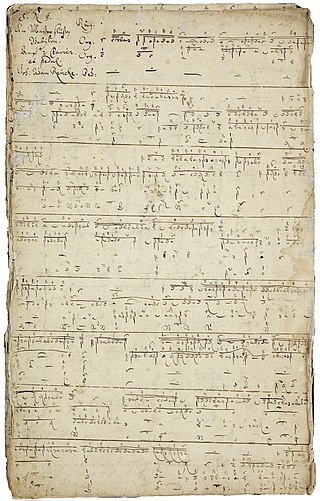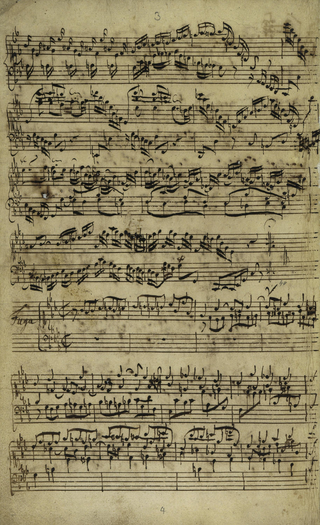
Johann Nikolaus Forkel was a German musicologist and music theorist, generally regarded as among the founders of modern musicology. His publications include the two-volume Allgemeine Geschichte der Musik, among the first attempts at a history of Western music and the "ground-breaking music bibliography" Allgemeine Litteratur der Musik. He also authored Johann Sebastian Bach: His Life, Art, and Work, the first substantial survey on the life and works of Johann Sebastian Bach.
Johann Caspar Ferdinand Fischer was a German Baroque composer. Johann Nikolaus Forkel ranked Fischer as one of the best composers for keyboard of his day; however, partly due to the rarity of surviving copies of his music, his music is rarely heard today.

Sechs Chorale von verschiedener Art: auf einer Orgel mit 2 Clavieren und Pedal vorzuspielen, commonly known as the Schübler Chorales, BWV 645–650, is a set of chorale preludes composed by Johann Sebastian Bach. Johann Georg Schübler, after whom the collection came to be named, published it in 1747 or before August 1748, in Zella St. Blasii. At least five preludes of the compilation are transcribed from movements in Bach's church cantatas, mostly chorale cantatas he had composed around two decades earlier.
Johann Christoph Bach was a musician of the Bach family. He was the eldest of the brothers of Johann Sebastian Bach who survived childhood.
As Thomaskantor, Johann Sebastian Bach provided Passion music for Good Friday services in Leipzig. The extant St Matthew Passion and St John Passion are Passion oratorios composed by Bach.

The concerto for two harpsichords in C minor, BWV 1060, is a concerto for two harpsichords and string orchestra by Johann Sebastian Bach. It is likely to have originated in the second half of the 1730s as an arrangement of an earlier concerto, also in C minor, for oboe and violin. That conjectural original version of the concerto, which may have been composed in Bach's Köthen years (1717–1723), is lost, but has been reconstructed in several versions known as BWV 1060R.

Schlage doch, gewünschte Stunde, BWV 53, is an aria for alto, bells, strings and continuo. It was likely composed in the early 18th century, although its date of first performance is unknown. From the second half of the 18th century until the early 1950s the aria was attributed to Johann Sebastian Bach. In 1955, it was suggested by the Bach scholar Karl Anton that the aria's composer was more likely to be a member of Melchior Hoffmann's circle.
Das ist je gewißlich wahr, TWV 1:183, is a cantata by Georg Philipp Telemann. Due to an erroneous attribution to Johann Sebastian Bach, it appears in the Bach-Werke-Verzeichnis (BWV) as No. 141, but was moved to Anhang III, the Appendix of spurious works, in the 1990s second edition of that catalogue.

The first major biographies of Johann Sebastian Bach, including those by Johann Nikolaus Forkel and Philipp Spitta, were published in the 19th century. Many more were published in the 20th century by, among others, Albert Schweitzer, Charles Sanford Terry, Christoph Wolff and Klaus Eidam.

The 1754 obituary of Johann Sebastian Bach is usually called the Nekrolog. It was published four years after his death.
Johann Sebastian Bach is a 19th-century biography of Johann Sebastian Bach by Philipp Spitta. The work was published in German in two volumes, in 1873 and 1880 respectively.

The Kyrie–Gloria Mass for double choir, BWV Anh. 167, is a mass composition in G major by an unknown composer. The work was likely composed in the last quarter of the 17th century. The composition has two sections, a Kyrie and a Gloria, each subdivided in three movements. It has twenty-two parts for performers: twelve parts for singers, and ten for instrumentalists, including strings, wind instruments and organ. Johann Sebastian Bach may have encountered the work around 1710, when he was employed in Weimar. In the 1730s he produced a manuscript copy of the Mass.
Johann Sebastian Bach's music has been performed by musicians of his own time, and in the second half of the eighteenth century by his sons and students, and by the next generations of musicians and composers such as the young Beethoven. Felix Mendelssohn renewed the attention for Bach's music by his performances in the 19th century. In the 20th century Bach's music was performed and recorded by artists specializing in the music of the composer, such as Albert Schweitzer, Helmut Walcha and Karl Richter. With the advent of the historically informed performance practice Bach's music was prominently featured by artists such as Nikolaus Harnoncourt, Gustav Leonhardt and Sigiswald Kuijken.
The Triple Concerto, BWV 1044, is a concerto in A minor for traverso, violin, harpsichord, and string orchestra by Johann Sebastian Bach. He based the composition on his Prelude and Fugue BWV 894 for harpsichord and on the middle movement of his Organ Sonata BWV 527, or on earlier lost models for these compositions.

An Wasserflüssen Babylon is a chorale fantasia for organ by Johann Adam Reincken, based on "An Wasserflüssen Babylon", a 16th-century Lutheran hymn by Wolfgang Dachstein. Reincken likely composed the fantasia in 1663, partly as a tribute to Heinrich Scheidemann, his tutor and predecessor as organist at St. Catherine's Church, Hamburg. With its 327 bars, it is the most extended repertoire piece of this kind. Reincken's setting is a significant representative of the north German style of organ music.

Fantasia and Fugue in C minor, BWV 906, is a keyboard piece, likely unfinished, composed by Johann Sebastian Bach sometime during his tenure in Leipzig (1723–1750). The work survives in two autograph scores, one with the fantasia alone, and the other, believed to have been penned around 1738 in which the fugue is incomplete. The piece is notable for being one of Bach's latest compositions in the prelude and fugue format, and for being a showcase of Bach trying his hand at the emerging galant and empfindsam styles of music that his sons were known to compose.
Walther Hermann Vetter was a German musicologist. From 1946 to 1958, he was professor at the Humboldt University of Berlin.
A Bach Temperament refers to the way the composer Johann Sebastian Bach tuned his harpsichords and clavichords for the interpretation, among other pieces, of his masterpiece Das wohltemperirte Clavier .










